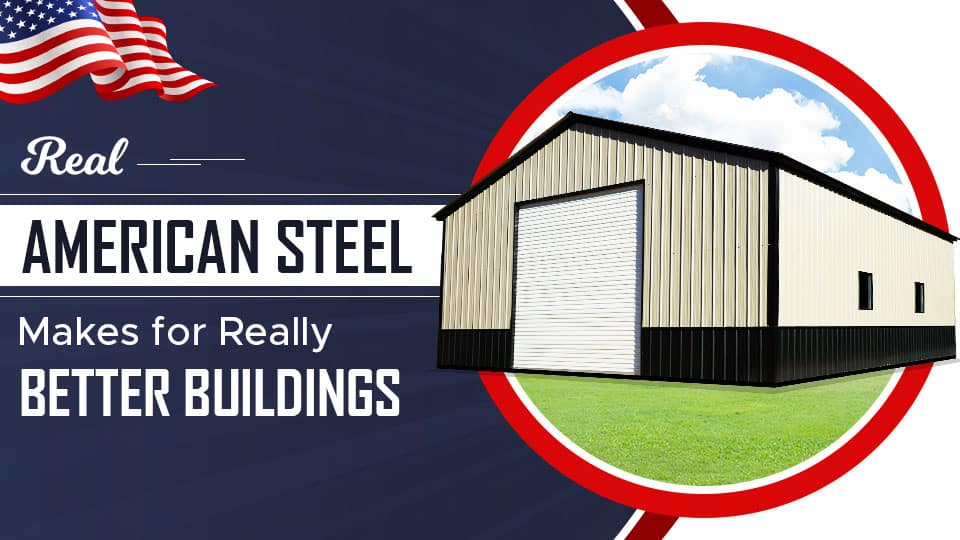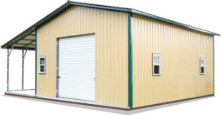27
Why Steel Buildings Outlast Everything: A Deep Dive Into Strength, Spans, and Smart Construction

TL;DR – Why Steel Buildings Outlast, Outperform, and Outbuild
Steel buildings aren’t just about durability—they’re about engineering smarter from the start. They offer unmatched tensile strength, clear span interiors up to 150 feet wide, and lower lifetime costs thanks to low maintenance and long-lasting finishes. If you’re comparing construction methods in 2025, prefab steel is leading the way in efficiency, fire resistance, and flexible design. Whether you’re building a home, garage, shop, or hybrid space—steel is the most future-ready material on the market.
1. What Makes Steel Structurally Superior?
Steel isn’t just another building material—it’s one of the strongest, most adaptable construction resources available today. When you compare it to traditional materials like wood or block, the performance difference is night and day.
Tensile Strength That Can Handle Almost Anything
- Steel has a tensile strength of up to 50,000 psi, compared to around 1,200 psi for wood.
- This makes it ideal for high-load applications like workshops, vehicle storage, RV shelters, and heavy-equipment garages.
- It holds up in severe weather, including snowstorms, high winds, and even seismic zones.
Better Load Bearing and Wind Resistance
- Steel buildings are engineered to code and often exceed local load requirements.
- Each frame is precision-designed to handle specific roof loads, wind loads, and lateral forces.
- This gives it a huge advantage in states like Texas, Florida, and the Carolinas, where seasonal storms can be intense.
Zero Risk of Warping, Rotting, or Termite Damage
- Unlike wood, steel doesn’t absorb moisture, split, or attract pests.
- That means no sagging trusses, no termite inspections, and no need to replace rotted beams down the road.
Fire Resistance Built Into the Frame
- Steel is non-combustible, making it a safer choice in wildfire-prone areas.
- When paired with fire-rated insulation and finishes, steel buildings can meet or exceed fire safety codes without chemical treatments.
2. Clear Span Construction: The Hidden Superpower of Steel Buildings
If you’ve ever walked into a wide-open steel garage or shop with no interior columns, that’s a clear span building—and it’s one of the most underrated advantages of going with steel.
What Is a Clear Span?
A clear span building is a structure with no interior load-bearing walls or supports, allowing you to use 100% of the interior floor space. Steel’s strength makes it possible to span widths up to:
- 40–60 feet for standard garages and shops
- 80–120+ feet for agricultural or light commercial buildings
- 150 feet or more for arenas, warehouses, or airplane hangars
Why It Matters for Real-World Use
Whether you’re housing vehicles, installing workbenches, storing machinery, or setting up open-floor event spaces—columns just get in the way. Clear span interiors give you:
- Total layout flexibility: Move equipment, add walls, or redesign the space later
- Easier access: Great for wide garage doors, RV pull-ins, or forklift clearance
- Future-proofing: Change your space without needing structural modifications
How Carport Central Optimizes Clear Span Steel Design
Our buildings are engineered to maximize both interior usability and structural integrity:
- We use galvanized steel trusses and precision-cut framing that maintain strength across large widths
- Each design is customized to your zip code’s wind and snow load requirements
- Need custom door placement or segmented zones inside? We can engineer that too—without disrupting the open feel
3. Prefab Precision: How Steel Building Kits Save Time, Labor, and Money
Prefab steel buildings aren’t just tough—they’re engineered to make the construction process smarter from the ground up. With factory-built components and fast on-site assembly, prefab kits are revolutionizing how people build everything from garages and shops to full-time homes.
What Makes Steel Building Kits Different?
- Pre-cut and pre-drilled components mean every piece arrives ready to install—no guesswork, no delays.
- Included anchor systems are matched to your foundation type (concrete, asphalt, gravel, etc.).
- No need for heavy carpentry or complex framing—it’s all engineered and ready to bolt together.
This isn’t just about saving time (though it can cut total build time by 30–50%). It’s about controlling costs, reducing waste, and building to exacting standards every time.
Faster Build. Lower Risk. Better Outcome.
Because prefab steel buildings are made in controlled environments:
- Weather delays during framing are practically eliminated.
- Installers spend less time on-site, which means fewer labor hours and less exposure to error.
- There’s minimal material waste—cutting down on cleanup costs and landfill impact.
In fact, this level of efficiency is one of the reasons so many first-time homeowners are turning to metal buildings. We explored this trend in our blog on residential steel building homes, which dives deeper into how prefab design is making affordable housing more accessible than ever.
4. Lifetime Cost: Steel vs. Wood — Not Even Close
When people compare steel to wood, they often focus on upfront price—but that’s only part of the story. The true value of a steel building emerges over time, thanks to drastically lower maintenance, longer material life, and greater durability.
Let’s Break It Down:
|
Feature |
Steel Building |
Wood-Framed Building |
|
Initial Build Cost |
Slightly higher (in some cases) |
Lower in materials, higher in labor |
|
Lifetime Maintenance |
Very low – no rot, termites, or sagging |
High – rot, mold, pests, repainting |
|
Fire Resistance |
Excellent – non-combustible frame |
Poor – needs treatment to reduce risk |
|
Interior Flexibility |
Wide clear spans, easy to modify later |
Limited by structural framing |
|
Longevity |
40–75+ years with proper upkeep |
20–35 years average lifespan |
External Source: According to SteelConstruction.info, well-maintained steel buildings can easily exceed 60 years of service life—especially when coated with protective finishes and placed on quality foundations.
A Smarter Investment Over Time
Steel buildings might not always win the race on day-one cost—but they dominate in lifetime ROI. You’ll save on:
- Termite inspections
- Pest control contracts
- Siding and framing repairs
- Insurance premiums in fire zones
And when it’s time to sell? Steel structures retain their value and appeal to modern buyers who prioritize durability, energy efficiency, and minimal upkeep.
A Quick Note on Financing
If the upfront cost has you on the fence, Carport Central offers flexible financing and rent-to-own plans designed to make long-term investment more accessible. Whether you’re building a two-car garage or a commercial-sized workshop, we’ve got plans that match your budget and timeline.
5. Looks Aren’t Sacrificed: Modern Steel Finishes & Red Steel Style
One of the biggest myths about steel buildings? That they all look like gray boxes. That may have been true decades ago—but today’s steel structures are engineered for aesthetics as much as strength. Whether you’re building a workshop, a garage, or something more custom, steel delivers on both form and function.
Engineered to Be Seen, Not Hidden
Steel building design has evolved. You’re no longer stuck with plain panels and limited choices. Instead, you get:
- Custom color options for roof, wall panels, trim, and doors
- Wainscoting and decorative paneling to add contrast and dimension
- Horizontal or vertical panel orientation depending on your visual preference
- Framed openings for windows and walk doors that feel like a modern home, not a warehouse
You can even blend architectural styles. Want a rustic exterior? Add stone veneer, faux-wood siding, or board-and-batten finishes. Want modern? Go with matte black panels and vertical lines. These aren’t gimmicks—they’re built into how we fabricate and frame the structure.
The Rise (and Return) of Red Steel Buildings
“Red steel” refers to the red oxide primer applied to interior steel framing—a traditional rust inhibitor that’s made a comeback not just for protection, but for its industrial-chic aesthetic. Builders and designers are embracing it for:
- Interior exposed-frame designs (think open-ceiling workshops or minimalist barn homes)
- Fire-resistance and coating longevity in high-moisture environments
- A bold, distinctive contrast when paired with white or black exterior panels
Want to go a step further? Pair the red steel look with clear span interiors, black framing accents, and natural wood textures to create a custom space that feels both industrial and warm—something you’d expect to see in a high-end workshop or modern farmhouse garage conversion.
Durability Meets Design
Looks aren’t everything—but with steel, you don’t have to choose between appearance and longevity. Every finish we offer at Carport Central is designed to:
- Resist fading and chalking from UV exposure
- Withstand rain, snow, and extreme heat
- Last decades with minimal repainting or upkeep
That means you get more than just a building that performs—you get one that looks good doing it, year after year.
6. FAQs – Everything You’ve Been Wondering
These are the questions customers ask us most when they’re seriously considering a steel building. If you’ve been Googling these, you’re not alone — and you’re in the right place.
What is a red steel building?
A red steel building refers to a structure built with red oxide–primed steel framing, named for the distinct reddish-orange coating applied during fabrication. This primer protects the steel from corrosion during transport and construction, and it’s especially popular in industrial, agricultural, and barn-style applications. The red hue also contributes to a bold, visible frame style when left exposed inside open-ceiling designs.
🔗 Learn more about finish options and frame coatings in our steel building customization guides on CarportCentral.com.
What is the maximum width of a clear span steel building?
Carport Central offers clear span widths up to 100–150 feet with no interior support columns. These are ideal for workshops, equipment storage, or wide-open multi-use spaces. Most residential and small business customers go with spans between 30 and 60 feet, which offer total layout flexibility for garages, RV storage, or hobbyist use.
Are steel buildings more expensive to insure?
Actually, steel buildings are often cheaper to insure than wood-frame structures. Why? Because they offer:
- Superior fire resistance (non-combustible frame)
- Greater structural integrity in storms
- No risk of termite or mold damage
Be sure to let your insurer know you’re using a certified steel frame system, and ask about discounts for fire-rated or engineered structures.
How long do prefab steel buildings last?
With proper installation and occasional maintenance, prefab steel buildings can last 50 to 75 years or more. Protective coatings, such as galvalume or powder-coated finishes, extend longevity even further. Unlike wood, steel won’t rot, warp, or decay — which drastically reduces maintenance costs over time.
📖 The Steel Construction Institute reports that structural steel can remain in service for 100+ years under the right conditions.
Do steel buildings rust over time?
Not if you use the right materials and coatings. All steel buildings from Carport Central include galvanized or galvalume steel with factory-applied coatings to prevent rust. Additional options include:
- Red oxide primer
- Painted panel systems with 20–40 year warranties
- Seam sealants and waterproof flashing upgrades
Regular inspection and cleaning (especially around ground-level trim or gutters) will help maximize the building’s lifespan.
Can I finance my steel building purchase?
Yes! Carport Central offers flexible financing and Rent-To-Own (RTO) programs for nearly all structures. Whether you’re building a small garage or a large shop, we can help you secure monthly payments that match your budget.
Visit our Financing Page or speak to a building specialist for current rates and requirements.
Final Thoughts
Steel buildings aren’t just the future—they’re the smart choice for right now. If you want unmatched strength, open-space design, modern styling, and serious longevity, a steel structure beats wood every time.
Get a custom quote, explore styles, or speak with a real building specialist today at CarportCentral.com.
We don’t just sell steel buildings—we build shelters for your way of life.
Get Started
It's fast and easy. Get your instant quote today!
BLOG TOPICS
- Condensation in Metal Buildings (2)
- News & Awards (12)
- Livestock sheds (4)
- Installations (15)
- Metal Buildings Applications (7)
- Customized Buildings (41)
- Carport Sizes (2)
- Facts (1)
- Certified Carports (2)
- COVID-19 (1)
- Prefab Metal Buildings (66)
- Metal Building Homes (6)
- Metal Building of the Week (11)
- Install of the week (1)
- Metal Building Extensions (1)
- Install of the month (2)
- Garages (52)
- Farm Show (1)
- Building Components (1)
- Carports (29)
- Storage Sheds (15)
- Metal Buildings (6)
- Barns (18)
- Metal Homes (8)
- Metal Sheds (1)
- RV Covers (6)
- 12 Gauge Framing (7)
- Workshops (7)
- Eagles & Buildings (1)
- Reviews (2)
- Snowfall in the Southeast (2)
- Carports and Buildings Prices (1)
- Reality Of Discounted Buildings (2)
- Snow Removal (1)
- Offers (3)
Metal Buildings
- Alabama
- Arizona
- Arkansas
- California
- Colorado
- Connecticut
- Delaware
- Florida
- Georgia
- Idaho
- Illinois
- Indiana
- Iowa
- Kansas
- Louisiana
- Maine
- Maryland
- Massachusetts
- Michigan
- Minnesota
- Mississippi
- Missouri
- Montana
- Nebraska
- Nevada
- New Hampshire
- New Jersey
- New Mexico
- New York
- North Carolina
- North Dakota
- Ohio
- Oklahoma
- Oregon
- Pennsylvania
- Rhode Island
- South Carolina
- South Dakota
- Tennessee
- Texas
- Utah
- Vermont
- Virginia
- Washington
- West Virginia
- Wisconsin
- Wyoming
Metal Garages
- Alabama
- Arizona
- Arkansas
- California
- Colorado
- Connecticut
- Delaware
- Florida
- Georgia
- Idaho
- Illinois
- Indiana
- Iowa
- Kansas
- Louisiana
- Maine
- Maryland
- Massachusetts
- Michigan
- Minnesota
- Mississippi
- Missouri
- Montana
- Nebraska
- Nevada
- New Hampshire
- New Jersey
- New Mexico
- New York
- North Carolina
- North Dakota
- Ohio
- Oklahoma
- Oregon
- Pennsylvania
- Rhode Island
- South Carolina
- South Dakota
- Tennessee
- Texas
- Utah
- Vermont
- Virginia
- Washington
- West Virginia
- Wisconsin
- Wyoming
Metal Carports
- Alabama
- Arizona
- Arkansas
- California
- Colorado
- Connecticut
- Delaware
- Florida
- Georgia
- Idaho
- Illinois
- Indiana
- Iowa
- Kansas
- Louisiana
- Maine
- Maryland
- Massachusetts
- Michigan
- Minnesota
- Mississippi
- Missouri
- Montana
- Nebraska
- Nevada
- New Hampshire
- New Jersey
- New Mexico
- New York
- North Carolina
- North Dakota
- Ohio
- Oklahoma
- Oregon
- Pennsylvania
- Rhode Island
- South Carolina
- South Dakota
- Tennessee
- Texas
- Utah
- Vermont
- Virginia
- Washington
- West Virginia
- Wisconsin
- Wyoming
- 100x100 Metal Building
- 12x12 Metal Shed
- 12x20 Carport
- 12x24 Carport
- 12x30 Carport
- 16x20 Carport
- 18x20 Carport
- 20x20 Carport
- 20x20 Metal Building
- 20x30 Carport
- 20x30 Metal Building
- 20x40 Carport
- 20x40 Metal Building
- 24x24 Carport
- 24x24 Garage
- 24x30 Carport
- 24x30 Metal Building
- 24x30 Metal Garage
- 24x36 Metal Building
- 26x30 Metal Building
- 30x30 Carport
- 30x30 Garage
- 30x30 Metal Building
- 30x40 Carport
- 30x40 Garage
- 30x40 Metal Building
- 30x40 Storage Building
- 30x50 Metal Building
- 30x60 Metal Building
- 40x100 Metal Building
- 40x40 Metal Building
- 40x60 Metal Building
- 40x80 Metal Building
- 50x100 Metal Building
- 50x50 Metal Building
- 50x80 Metal Building
- 60x100 Metal Building
- 60x120 Steel Building
- 60x60 Metal Building
- 60x80 Metal Building
- 80x100 Metal Building
- All Steel Carports
- American Building Network
- American Custom Carports
- American Steel Carports
- Arkansas Carports
- Best Choice Metal Structures
- California All Steel
- Carports Outlet
- Central Texas Metal Buildings
- Coast To Coast Carports
- Custom Steel Structures
- Dreams Carports and Buildings Inc
- East Coast Carports
- Enterprise Steel Structures
- Infinity Carports
- Interstate Steel Structures
- Long Horn Buildings
- Midwest Steel Carports
- NC Structures
- New Team Carports
- Northside Metal Carports
- Quality Carports
- Rhino Carports
- Safeguard Metal Buildings
- Southern Steel Buildings Inc.
- Steel Buildings and Structures
- Tennessee Steel Buildings
- Tubular Building Systems
- Ultimate Metal Buildings
- United Structures
- USA Carports







